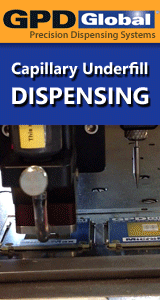Electronics Manufacturing Productivity Facility (EMPF)

The EMPF serves as a corporate residence of expertise in electronics manufacturing.
The Electronics Manufacturing Productivity Facility (EMPF) was established in 1984 to aid the electronics industry in improving electronics manufacturing processes required in the manufacture of military systems. Today, the EMPF operates as a national electronics manufacturing center of excellence deriving its resources from partners in industry, university and government led by the American Competitiveness Institute (ACI). The EMPF serves as a corporate residence of expertise in electronics manufacturing. The EMPF's principal goals are to: improve responsiveness to the needs of DoD electronics systems; ensure that deliverables make a significant impact in the electronics manufacturing industry; facilitate the development and transition of technology to the factory floor; and, expand the customer base to a national level.
The EMPF operates in a modern facility adjacent to the Philadelphia International Airport with easy access from I-95. The facility houses a 10,000 square foot demonstration factory; fully-equipped classrooms; an analytical laboratory for materials and environmental testing; conference and lecture rooms with video conferencing capabilities; and an easily accessible technical library.
The EMPF offers many electronics manufacturing services and capabilities to the U.S. Navy, DoD and the U.S. electronics manufacturing industrial base. The EMPF's resident technical staff, most of whom have advanced degrees, consists of the nation's leading electrical engineers, mechanical engineers, materials scientists, chemists, physicists, instructors and technicians. The EMPF staff is dedicated to the advancement of environmentally safe electronics manufacturing processes, equipment, materials and practices; flexible electronics manufacturing technologies; and workforce competency in advanced electronics manufacturing.
Electronics Manufacturing Productivity Facility (EMPF) Postings
6 technical articles »
Apr 15, 2010 | Michael D. Frederickson, EMPF Director; Barry Thaler, Ph.D. EMPF Technical Director Empfasis Technical Editor; Paul Bratt, Empfasis Editor.
As electronic products increase in functionality and complexity, there is an emphasis on affordability, miniaturization, and energy efficiency. The telecommunications, automotive, and commercial electronic markets are the leading drivers for these trends. These markets see high volume manufacturing with millions of units priced to the fraction of the cent. The choice of the packaging material for the electrical components for these markets can have a substantial effect on the cost of the final product. Therefore plastic encapsulated components are almost universally used in non-military applications over the conventional ceramic or metal electronic packages....
Advanced Electronic Connector Technologies
Nov 27, 2008 | Fred Verdi, Senior Manufacturing Engineer, ACI-EMPF.
Military electrical connectors have traditionally used very conservative design rules that provide the ruggedization needed for harsh military use environments. Commercial electronic connectors have typically used less conservative design rules that....
Jan 24, 2008 | Paul Bratt, Lead Package Engineer
Although many through-hole components are being replaced by their surface mount (SMT) counterparts, printed circuit boards (PCBs) are still being designed with both types of components. Often, there are interconnect hardware, displays, or other components that cannot withstand the exposure to the high temperature involved in the wave soldering process. They are generally soldered by hand. The challenge is to determine the optimal method manufacturers can use to solder these boards populated with mixed technology....
RF Packaging Advancements for Navy Applications
Oct 02, 2007 | Fred Verdi, EMPF Technical Director
The vast majority (99%) of the electronics market in North America is composed of products produced for commercial applications. The 1% share of the electronics market driven by Department of Defense (DoD) applications has created a niche market for RF qualified devices. The DoD, with its emphasis on COTS (Commercial Off The Shelf) and "Open" systems, is beginning to become more interested in using commercially oriented RF devices for military applications as a means to leverage the volumes and innovations of the commercial world....
Characteristics of Conformal Coatings
Aug 28, 2007 | Dave Poulin, Senior Materials Engineer, EMPF.
A conformal coating is defined as a thin polymeric material which covers the surface of an electronic assembly. These coatings are used to provide an electrically insulative and environmentally protective seal or cover to a completed printed circuit board (PCB)....
Reduced Oxide Soldering Activation (ROSA)
Jul 19, 2007 | Sam Pepe, Chemist, American Competitiveness Institute / EMPF
ROSA is a surface restoration technique that removes hard to reduce species like metal oxides or sulfides. At the time of its development, the focus was on solderability and compliance to environmental regulations. Industry trends and regulatory changes as a result of the Montreal Protocol were the driver for much of the concern over environmental compliance. The result was an increase in the development of no-clean and water soluble fluxes and the removal of halogenated cleaning chemistries....






